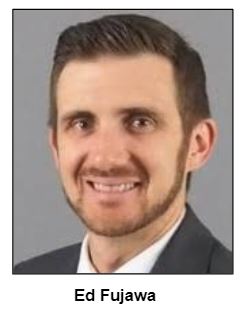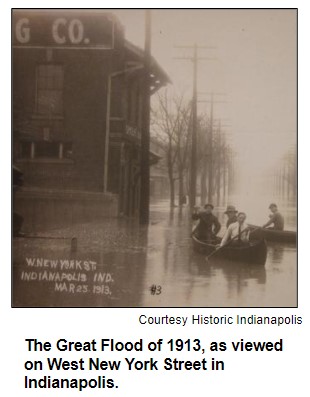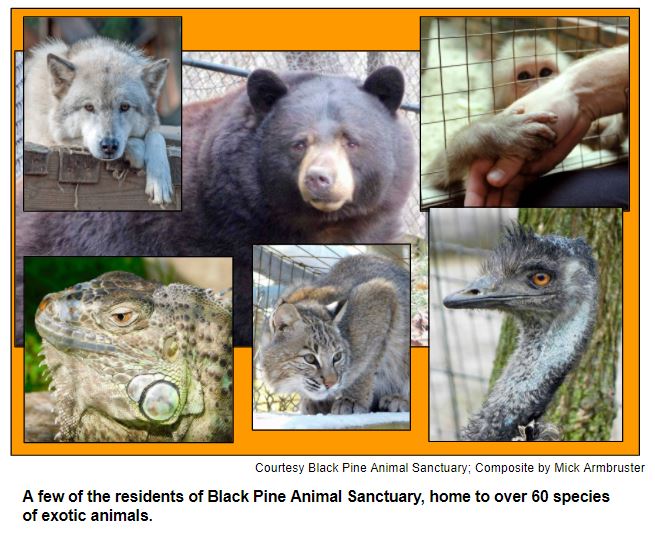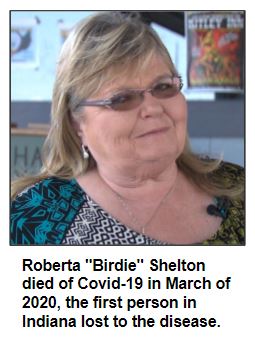Saturdays, noon to 1 p.m. ET on WICR 88.7 FM.
Or stream audio live from anywhere on WICR Online!
April 17, 2021
Bear pit at Riverside Park and other bygone animal attractions - encore
Bears at Riverside Park in Indianapolis? Not for the last century. But for nearly two decades beginning in 1899, a bear pit was among the most popular attractions at the park near the White River.

And the Riverside bear pit, although the longest-lasting and most significant local animal attraction during the era (it even sometimes was casually referred to as a "zoo"), wasn't the only collection of wildlife on display in Indianapolis parks.
The popularity of the attraction at Riverside led to a public exhibit of bears at Garfield Park beginning in 1905, according to research by attorney Ed Fujawa, who will be Nelson's guest. Monkeys also were exhibited for a few years at Garfield Park - as well as, even more briefly, at Brookside Park, where visitors also could gaze at exotic birds.
Ed, the creator of the history blog Class 900: Indianapolis, has written about the Riverside bear pit. An adventure lover, Ed hiked around Riverside to find remnants of the bygone bear pit, discovering the two arched doorways for the den amid trees, rocks and brush.

Of the bygone Riverside Park bear pit, Ed Fujawa writes: "While the bears and other animals were popular with visitors, the conditions in which the animals were kept were not ideal." He describes letters of complaint in 1900 to Indianapolis newspapers.
Ed elaborates on the poor treatment of park animals at the time, calling them "disgraceful, especially when compared to modern standards. The animal pens were too small, especially for the bears, and the staff of the parks often did not take action to protect the animals from outside influences, such as visitors to the park, or natural disasters."
His blog post recounts floods of the nearby White River that resulted in "close calls" for the bears, who "climbed trees and logs placed in the pit to escape the encroaching water."
 According to Ed, a female bear at Garfield Park named Minnie died in 1905 after being fed buckeyes by the public. Local newspapers speculated that buckeyes were poisonous to the bear.
According to Ed, a female bear at Garfield Park named Minnie died in 1905 after being fed buckeyes by the public. Local newspapers speculated that buckeyes were poisonous to the bear.
With his Class 900 blog, Ed focuses on unearthing Indy history that's often been overlooked or forgotten. In 2020, he was a Hoosier History Live guest for a show about tree-planting crusades in Indy that began in the 1850s. Even then, city residents were worried about the loss of tree canopy in the urban area.
During the early 1900s, greenhouses at Garfield Park were used in the winter to house some of the animals from Riverside Park, including the monkeys, Ed says. Bears remained at Riverside, sheltering in their den during the winter.
In 1904 the bears managed to survive a flood of the nearby White River by climbing trees and logs (Ed describes the local newspaper accounts as "heartbreaking"), but some of the smaller animals and birds at Riverside drowned. The impact on the bear pit of the Great Flood of 1913, the worst flood in Indiana history, is unclear, Ed says.
When the last remaining bear at Riverside died in 1917, the animal display closed. The arched doorways of the den and other remnants of the bear pit are challenging to find today, Ed reports. "The site of the bear pit was later converted into a rock garden, which likely explains the numerous rocks spread throughout the site when I visited."
Like many other Indianapolis history lovers, Ed initially learned about the bygone bear pits at the parks by discovering vintage postcards depicting them. He reports that postcards of the animal exhibits are regularly sold on ebay and other sites featuring city memorabilia.
Roadtrip: Black Pine Animal Sanctuary in northern Indiana

In contrast to the cruel conditions in which wild animals were displayed for public viewing in the early 20th century, modern animal refuges and sanctuaries make it their mission to provide comfortable, spacious habitats for captive-raised exotic animals.
To explore one such refuge, guest Roadtripper Steven Johnson, speaker and author, suggests we visit Black Pine Animal Sanctuary in Albion, Indiana.
Located in Noble County in northern Indiana, the Black Pine Animal Sanctuary has over 60 species of exotic animals including bears, cats, wolves, birds and more. In addition to providing homes to displaced animals, Black Pine strives to "educate people about responsible animal care and conservation."Most of the animals at Black Pine have been surrendered by owners who came to realize that they could not care for them properly. The sanctuary serves as a kind of retirement home for these animals, with care provided by professional animal keepers.
If you wish to visit Black Pine Animal Sanctuary in person after the season opens on May 8th, you can pre-register and pay admission for a guided tour by signing up on their website. Steven recommends a visit on the weekends, when tours include animal feedings.
You can also take a virtual Roadtrip to the sanctuary on their YouTube channel.
History Mystery

The Riverside Park area in Indianapolis was far better known during the 20th century for an amusement park that lasted nearly 70 years rather than the bear pit, which was gone by the 1920s.
Generations of Hoosier children first experienced the thrill of riding a roller coaster and Ferris wheel at Riverside Amusement Park, which opened in 1903. Attractions eventually included a water slide, a miniature railroad and two roller coasters.
The two roller coasters were presented as rivals. For decades until the amusement park closed in 1970, children argued about which of the roller coasters was more thrilling. Both of them had names.
Question: What was the name of at least one of the two roller coaster rides at Riverside Amusement Park?
The call-in number is (317) 788-3314. Please do not call in to the show until you hear Nelson pose the question on the air, and please do not try to win if you have won any other prize on WICR during the last two months. You must be willing to give your first name to our engineer, you must answer the question correctly on the air and you must be willing to give your mailing address to our engineer so we can mail the prize pack to you.
The prizes this week are two tickets to the Benjamin Harrison Presidential Site, courtesy of the Benjamin Harrison Presidential Site, and four tickets to Indy's Teeny Statue of Liberty Museum, courtesy of Tim and Julie's Another Fine Mess.
Share our Hoosier History Live podcasts, please!

Attention all guests, fans, listeners, critics, readers, and more. Please copy and paste any of our podcast links to any website, social media platform, or blog! This is better for our "numbers" and distribution.
Just please don’t edit them.
Can't find a particular podcast you'd like to share or listen to? Click here to get to a searchable index of our shows and podcasts. You can also click the link at the top of our website and newsletter for the last three shows that were on the air.
Nelson Price, host and historian
Molly Head, producer/general manager, (317) 927-9101
Mick Armbruster, associate producer
Cheryl Lamb, administrative manager
Richard Sullivan, senior tech consultant
Pam Fraizer, graphic designer
Garry Chilluffo, consultant
Please tell our sponsors that you appreciate their support!

 For organizational sponsorship, which includes logos, links, and voiced credits in the show and in podcasts, email molly@hoosierhistorylive.org, or call (317) 927-9101 for information. Our podcast listens are increasing and we are being distributed on Indiana Memory and the National Digital Public Library. Grow with us as our podcast and internet presence expands! Thanks also to Visit Indy, Fraizer Designs, WICR-FM, Henri Pensis, Genesis Brown, Kielynn Tally, Heather McIntyre, Justin Clark, and many other individuals and organizations.
For organizational sponsorship, which includes logos, links, and voiced credits in the show and in podcasts, email molly@hoosierhistorylive.org, or call (317) 927-9101 for information. Our podcast listens are increasing and we are being distributed on Indiana Memory and the National Digital Public Library. Grow with us as our podcast and internet presence expands! Thanks also to Visit Indy, Fraizer Designs, WICR-FM, Henri Pensis, Genesis Brown, Kielynn Tally, Heather McIntyre, Justin Clark, and many other individuals and organizations.
Thank you!
We'd like to thank the following recent, new and renewal contributors whose donations help make this show possible!
- John Stanton
- Kathleen Angelone
- Tim and Meg Shelly
- Connor & Company, Inc.
- Georgia Cravey and Jim Lingenfelter
- Ann Frick
- Yetta Wolen
- In memory of William G. "Bill" Mihay
- Dr. William McNiece
- Michael Freeland and Sharon Butsch Freeland
- David E. and Lynne J. Steele
- Stacia Gorge
- Margaret Smith
- Rachel Perry
- Tom and Linda Castaldi
- Greg Larson
- Marion Wolen
April 24, 2021 - coming up
Covid history in Indiana

During this show, we also will compare the spread in urban and rural areas, describe early challenges in contact tracing and explore other aspects of the emerging epidemic. Nelson will be joined by a journalist who has covered the impact of Covid-19 in Indiana since it entered public awareness.
Shari Rudavsky, the health and medical reporter for the Indianapolis Star, wrote a front-page story last month that described the earliest Hoosier cases of Covid-19 that "provided a harbinger of dark days." Shari, who has a PhD in the history and sociology of science, wrote about the state's first case, which was diagnosed in early March 2020. A patient at Community Hospital North in Indianapolis, the man (whose name has never been released) "was well enough to ride out his illness in a hotel quarantined from his family," Shari reported.

Also in March 2020, Shari wrote about the challenges that suddenly were confronting hospitals in rural areas and small cities, including Good Samaritan Hospital in Vincennes.
During our show, Shari and Nelson also will discuss an early outbreak in Logansport at a Tyson Foods meat-packing plant, the largest employer in Cass County.
Shari also will share insights about, as she puts it, "the challenges of explaining new terminology and new science - such as coronavirus, spike protein [and] other terms - that previously were unknown to most readers, including myself."
Copyright 2021
|







